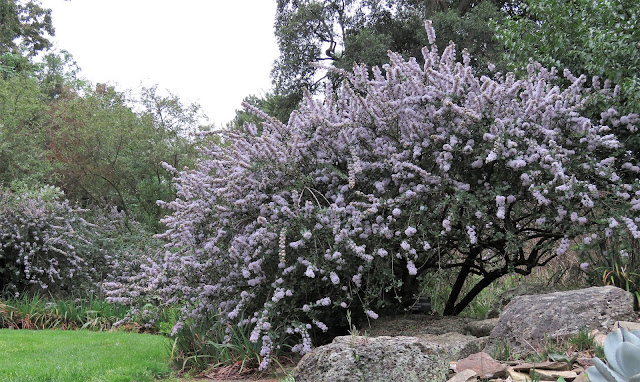Insects crawl on petal's claw
And while I'm in the California Garden, as I was last week, let me tell you a little about Kern Ceanothus or Coville Ceanothus.
Ceanothus pinetorum was popping with pink flowers in late August, looking very much like an early-flowering prunus. Although Ceanothus is in the buckthorn family, Rhamnaceae, in our constructed tree of life we group this family not too far away from the rose (and prunus) family, Rosaceae.
The Californian Ceanothus are also known as the Californian Lilac, which points to another floral similarity. But not an evolutionary one, with the true lilac, Syringa, in the olive family.
The species name 'pinetorum' is a reference to where it grows naturally, in pine forests, in this case in meadows (near pine trees presumably) on Kern Plateau and Trinity Mountains in California. This doesn't tell you much about what distinguishes Kern Ceanothus from the other 50 or so other species of Ceanothus. That is mostly leaf shape and size, and its high altitude habitat.
The site of its original discovery to science accounts for one of its common names, Kern Ceanothus. The Kern River runs through California about half way between LA and San Francisco, from the southern Sierra Nevada into an an inland lake, at least before it was entirely diverted for irrigation.
Apparently Ceanothus are nitrogen-fixing shrubs, presumably through symbiotic bacteria in their roots like some of our native and garden legumes. This would allow them to live in what look like rather harsh and depauperate conditions on rocky hillsides.
The other common name is a reference to the scientific discoverer of the species, Fredrick Coville. Coville was a botanist and plant collector who worked for the US Department of Agriculture in the late nineteenth century. He first described this species in 1893 from a specimen he collected, on Kern Plateau.
The flowers of Ceanothus are intriguing and might take a little deciphering. The outer layer - the sepals - are white and look just like petals. The petals themselves are what we call 'clawed' which means they are stalked. So those white tennis-racket-like extensions are the petals. The yellow-tipped male parts, the stamens, extend as far out as the petals.
In the middle you can see a purple fleshy ring around the also purple female reproductive part, the style. That ring or disk presumably secretes nectar to attract pollinating insects, of the sort in the picture above and below. Crawling on the claws, and more...





Comments